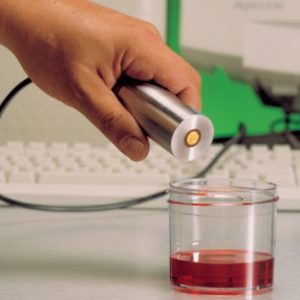The DT-300 works according to the electroacoustic principle and thus can analyze the zeta potential in dispersions in its original state (without dilution or modification). Further important colloidal parameters can be calculated like isoelectriv point (IEP), Debye length, κa-value, Dukhin number and surface charge density in case of strong non-polar solvents.
Due to the smart design of the probe (pulse-echo method, smooth surface) it can be easily used both for laboratory experiments and for process-near online measurements.
The electroacoustic spectrometer DT-310 offers the additional possibility of titration experiments by means of a titration unit with two separate controllable burettes. This fully software-controlled unit is designed to enable the zeta potential measurement independent of the pH or the amount of an additive (further details see “accessories” below).


Zeta probe
/1/ ISO 13099-3 Colloidal systems – Methods for zeta potential determination.
/2/ A. Dukhin, P. Goetz: Characterization of Liquids, Nano- and Microparticulates, and Porous Bodies using Ultrasound. 2nd Edition. Oxford: Elsevier, 2010.
/3/ PARTICLE WORLD 19; p. 18 – 19; “Characterization of liquids, dispersions, emulsions and porous materials using ultrasound”.
This software-controlled unit is designed to enable the particle size and zeta potential measurement independent of the pH or the amount of an additive. The system can be programmed to carry out automatically different types of protocols (dosing amount of additive/acid/base, pH-value and time).
This option consists of a stirrer, a heavy-duty stand and a vessel made of special glass. The sample volume and stirrer design prevent funneling of the sample below the probe, allowing accurate measurements.
Two different probes are available to measure the electric conductivity. Both are fully integrated in the DT-software:
The probe for measurements in organic solvents is also available as a separate device: DT-700.